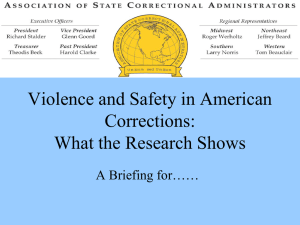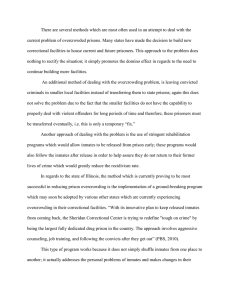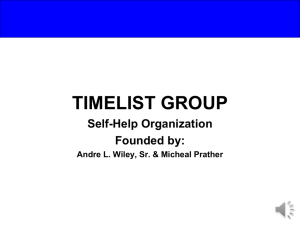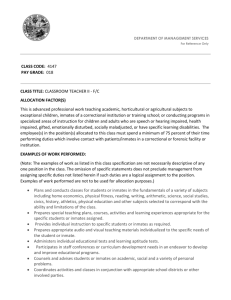An Empirical Examination of a Vulnerable Population in Prison
advertisement
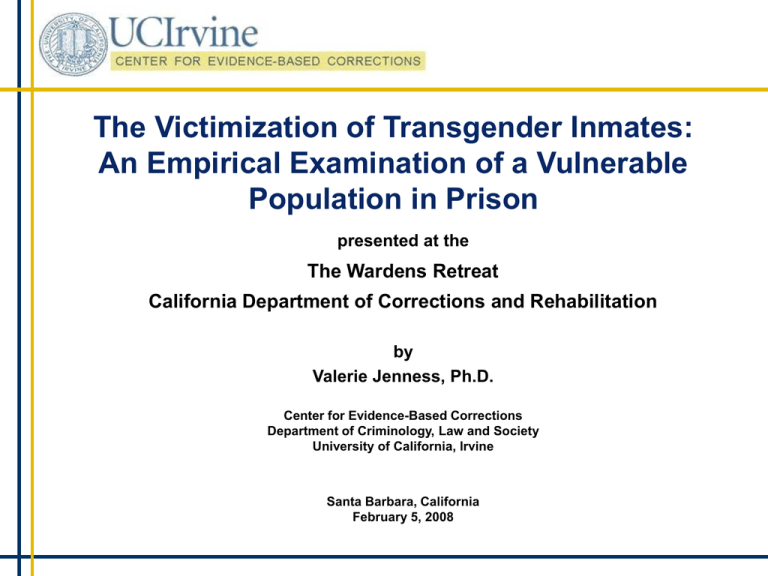
The Victimization of Transgender Inmates: An Empirical Examination of a Vulnerable Population in Prison presented at the The Wardens Retreat California Department of Corrections and Rehabilitation by Valerie Jenness, Ph.D. Center for Evidence-Based Corrections Department of Criminology, Law and Society University of California, Irvine Santa Barbara, California February 5, 2008 Objectives 1. Describe the context for research 2. Summarize past related research 3. Introduce current plans for research 4. Solicit feedback, input, and cooperation 1. The Context for Research Why Research? Why Research on Transgender Inmates? Evidence-Based Corrections: From Principle to Practice The CDCR Mission: The overarching mission is to improve public safety through evidence-based crime prevention and recidivism reduction strategies. What is “Evidence-Based Corrections?” The conscientious, explicit, and judicious use by correctional administrators of current best research evidence in selecting programs designed to manage offenders, reduce recidivism, and increase public safety (Grattet 2005). Why Research on Sexual Assault/Transgender Inmates? • Legislative Mandates – Prison Rape Elimination Act – Sexual Abuse in Detention Elimination Act • Legal Concerns – Farmer v. Brennan – Giraldo v. the CDCR • Insufficient research Highlights of the PREA • Supports the elimination, reduction, and prevention of sexual assault within corrections system • Mandates several national data collection activities • Creates a national commission to develop standards and accountability measures • Provides funding for program development and additional research Sexual Abuse in Detention Elimination Act “…the purposes of which would be to protect all inmates and wards from sexual abuse while held in institutions operated by the Department of Corrections and the Department of the Youth Authority…” “This law lays the foundation for California, the largest prison system in the country, to be a national leader in the fight to end prisoner rape.” --Stop Prisoner Rape Farmer v. Brennan (1994) Giraldo v. the CDCR (2007) Why Research on Transgender Inmates? • In March 2004 NIJ published a comprehensive literature review of the existing research titled "Prison Rape: A Critical Review of the Literature," which: – Describes research conducted since 1968 – Describes both convergence and divergence across findings, noting the difficulties encountered when comparing across facilities of different sizes, security levels, missions, types of inmates, etc. – Describes how conducting such research presents a unique set of challenges – Offers suggestions to help guide future research – But, only one prison in California studied! • Violence in California Correctional Facilities: An Empirical Examination of Sexual Assault (2007), by Valerie Jenness, Cheryl L. Maxson, Kristy N. Matsuda, and Jennifer M. Sumner. A report submitted to the CDCR. 2. Past Related Research Violence in California Correctional Facilities: An Empirical Examination of Sexual Assault (2007), by Valerie Jenness, Cheryl L. Maxson, Kristy N. Matsuda, and Jennifer M. Sumner.* *For details, see the Bulletin in the folder distributed at the retreat. Violence in California Correctional Facilities: An Empirical Examination of Sexual Assault Report submitted to the California Department of Corrections and Rehabilitation by Valerie Jenness Cheryl L. Maxson Kristy N. Matsuda Jennifer Macy Sumner Criminology, Law and Society University of California Irvine, California 92697-7080 Center for Evidence-Based Corrections April 27, 2007 Purpose of the Study Key Questions: 1.What proportion of inmates in California prisons housing adult males has been sexually assaulted in a California correctional facility? 2. What are the demographic characteristics of victims? 3. What are the contextual and relational characteristics of the sexual assault/misconduct incidents reported by inmates in California prisons housing adult males? Main Objective: By addressing these questions, this study sheds insight into the contours of sexual assault in order to contribute to ongoing efforts to create viable interventions designed to prevent and respond to sexual assault in ways that are humane, effective, and constitutional. Select Differences between the Random Sample and the Transgender Sample Random Sample Transgender Sample Prevalence of Sexual Assault 4.4% 59% Prevalence of undesirable sexual acts 1.3% 48.3% Weapon actually used if involved 20% 75% Officer Aware of the Incident 60.6% 29.3% Provision of Medical Attention (if needed) 70% 35.7% Racial composition (% of incidents interracial) 17.2% 63.9% Relational Distance Evenly distributed Skewed toward familiarity Recommendations: Research • Research on other incarcerated populations, such as women and juveniles. – Additional research on transgender inmates, nonheterosexual inmates, inmates of color, inmates with mental health problems, and inmates that are small in stature. • Collect empirical data on a broader range of types of sexual assault, especially – staff-on-inmate assault. • Focus empirical research on perpetration as well as victimization to ascertain if there are similar patterns and correlates. • Support studies that assess current efforts to respond to sexual assault in California correctional facilities. Post Report “Hearing” and “Discussion,” Pt. I Violence in California Correctional Facilities: An Empirical Examination of Sexual Assault (2007), by Valerie Jenness, Cheryl L. Maxson, Kristy N. Matsuda, and Jennifer M. Sumner. • Orally presented to the wardens in attendance at the Wardens retreat at Green Valley Training Center on May 16, 2007 and thereafter to the Secretary and Executive Staff of the CDCR on May 20, 2007. • Orally presented to a plethora of audiences with a stake in prison violence, including a state level Commission devoted to reducing sexual assault in prisons, Executive Officers and staff for Stop Prisoner Rape (SPR), the Executive Director of the National Prison Rape Elimination Act Commission, and the Chief of Staff for the California Majority Whip, Assemblywoman Fiano Ma. • Entered into evidence and orally presented in a recent high profile Superior Court trial in San Francisco, Alexis Giraldo v. the California Department of Corrections and Rehabilitation, which involved a transgender inmate unsuccessfully suing the CDCR for failing to protect her from serial sexual assault in Folsom State Prison. Post Report “Hearing” and “Discussion,” Pt. II • Posted on multiple organizations’ web pages, including the Center for Evidence-Based Corrections at the University of California, Irvine, the National Institute of Corrections, Stop Prisoner Rape, Corrections Community, AELE Law Enforcement/Legal Center, and the California Coalition Against Sexual Assault. Note: In less than seven months (from June 2007-December 2007), over 13,500 “hits” are associated with this report on the web site for the Center for Evidence-Based Corrections at the University of California, Irvine—far more than any other report posted on the Center’s website. • Referenced in an Associated Press article that appeared in over 30 newspapers, including The Los Angeles Times, the San Francisco Chronicle, The Guardian (in London), Forbes, The San Diego Union-Tribune, The Houston Chronicle, The San Francisco Examiner, and The Washington Post. • Referenced in testimony given by Wendy Still, Associate Director, CDCR, before the National Prison Rape Elimination Commission in New Orleans, Louisiana on December 5, 2007. Acknowledgments • • • • • • • • • • • • • • • CDCR Bubpha Chen John Dovey Sharon English Nola Grannis Nancy Hardy Kimberly Kaufman Sandi Menefee Wendy Still Jeanne Woodford Wardens and other prison administrators and correctional officers at seven prisons from which data were collected Research Consultants Allen Beck Mark Fleisher Alexander L. Lee Merry Morash Andie Moss • • Stop Prisoner Rape Lovisa Stannow Lara Stemple • • • • • • • • • • • • • UC Research Team/Consultants Victoria Basolo Lyndsay Boggess Philip Goodman Ryken Grattet John Hipp Lynn Pazzani Joan Petersilia Amelia Regan Michael Smyth Rebecca Trammell Susan Turner Sylvia Valenzuela Guadalupe Vidales • Inmates Hundreds whose names will remain confidential Now what? 3. Current Plans for Research The Victimization of Transgender Inmates: An Empirical Examination of a Vulnerable Population, Valerie Jenness* *For more details, see Exhibit A, Agreement #C07.227 in the folder distributed at the retreat. Rethinking, revising, and elaborating! Previous Research Design ADULT MALE INSTITUTIONS Six Facilities* Roster (Non-Reception Center, non-EOP) Random Selection of Inmates Secure Informed Consent INTERVIEW INSTRUMENT Life in Prison/Routine Activities; Social Support in Prison; Inmate General WellBeing/Emotional Health; Fear of Victimization in Prison; Actual Victimization in Prison; Opinions on Safety and Reporting; Demographics, including Gang Affiliation, Criminal History, and Past and Current Incarcerations * Data were also collected from a seventh prison in order to over sample transgender inmates. Previous Data Collection (April 26, 2006 – October 4, 2006) Adult Male Population (Not in Reception Centers or Fire Camps and Not EOP) Prison 1 4/26-27, 5/9 *64/53/52 Prison 2 5/10-12 *42/35/34 Prison 3 5/15-18 *93/81/81 Prison 4 Prison 5 Prison 6 Prison 7 5/23-25, 6/14-15 5/30-6/2 6/6-9 9/6-7, 10/4 *46/43/39 *82/71/69 *73/61/60 *29/26/26 *First number = Total number of inmates seen; Second number = Total number of inmates who consented to be interviewed; Third number = Total number of usable interviews. Previous Samples: Size and Participation Rate • Random Sample – Total = 322 – Participation Rate = 83.5% • Transgender Sample – Total = 39 – Participation Rate = 93.5% Assessment of Previous Samples • • Random Sample – Statistically similar to the population of inmates in the six prisons from which data were collected – Statistically comparable to the CDCR population in terms of sex offender registration and “lifer status” – Statistically different from the CDCR population in terms of age, race/ethnicity, offense category, custody level, gang status, and mental health problems – The magnitude of the statistical differences between the sample and the CDCR population is small, but the study sample has fewer Hispanic inmates and more inmates with officially recognized mental health issues Transgender Sample – Not designed to generalize to larger populations Current Research Design ALL ADULT INSTITUTIONS 33 Facilities List of TG inmates (Non-Reception Center, non-EOP) Identification and Selection of all Transgender Inmates Secure Informed Consent Face-to-Face Interview, with a focus on: PART I: Housing History PART II: General Perceptions and Actual Experiences PARTIII: Individual/Demographic Characteristics The UCI Interview Schedule* Preamble/Informed Consent Housing History, with a focus on four dimensions of the housing environment: 1. Physical location/conditions Interactional/network conditions Perceptual dimensions Experiential dimensions General Perceptions and Experiences of Incarceration: 2. Opinions of safety and housing Understandings/interpretations of violence History of actual victimization while incarcerated and in the community Individual Characteristics: 3. Education Family Gang and substance abuse history Identity Incarceration * This list reflects the current draft of the instrument, but not necessarily the final draft of the instrument. Current Interview Format Prison 1 Prison 2 Inmate1 Housing1 Prison 3 Housing2 Prison 4 Housing3 Inmate2 Physical Location/Conditions Inmate3 Interactional/Network Conditions Perceptual Dimensions Inmate200+ Experiential Dimensions Prison 33 Housing? Key Tasks and Estimated Timeline Complete Literature Review Complete Draft of Interview Instrument Pilot Test Interview Instrument Complete Report on State/Local Policies on Transgender Inmates Complete Training Manual for Interviews Conduct Training for Interviewers Complete Final Interview Instrument Obtain Official Roster of TG Inmates from Facilities Obtain C-File/OBIS Data from CDCR Complete Interview Data Collection Complete Working Draft of Codebook for Interview Data Complete Data Coding, Entry, & Cleaning Complete Final Draft of Codebook for Interview Data Complete Data Analysis for Final Report Submit Final Report to the CDCR January 28, 2008 January 28, 2008 January 28, 2008 January 28, 2008 February 1, 2008 February 15, 2008 February 29, 2008 March 14, 2008 March 31, 2008 July 1, 2008 July 1, 2008 August 31, 2008 August 31, 2008 October 31, 2008 December 30, 2008 4. Soliciting Feedback, Input, and Cooperation Help!!!!! Acknowledgments • • • • • • • • • • • • • • • CDCR Bubpha Chen John Dovey Sharon English Nola Grannis Nancy Hardy Kimberly Kaufman Sandi Menefee Wendy Still Jeanne Woodford Wardens and other prison administrators and correctional officers at seven prisons from which data were collected Research Consultants Allen Beck Mark Fleisher Alexander L. Lee Merry Morash Andie Moss • • Stop Prisoner Rape Lovisa Stannow Lara Stemple • • • • • • • • • • • • • UC Research Team/Consultants Victoria Basolo Lyndsay Boggess Philip Goodman Ryken Grattet John Hipp Lynn Pazzani Joan Petersilia Amelia Regan Michael Smyth Rebecca Trammell Susan Turner Sylvia Valenzuela Guadalupe Vidales • Inmates Hundreds whose names will remain confidential Key Concerns 1. Identifying transgender inmates in all prisons 2. 3. Accessing all transgender inmates/providing all transgender inmates an opportunity to be interviewed Determining the scope of move history captured: 4. 5. Wardens Inmate Support Groups Health Records/Dr. Lori Kohler Time frame What “counts” as a housing assignment Capturing multiple dimensions of “housing environments” Scheduling data collection at all 33 facilities within a tight time frame Contact information Valerie Jenness, Ph.D. Department of Criminology, Law & Society University of California Irvine, California 92697-7080 Tel: (949) 824-3017 FAX: (949) 824-3001 E-mail: jenness@uci.edu


